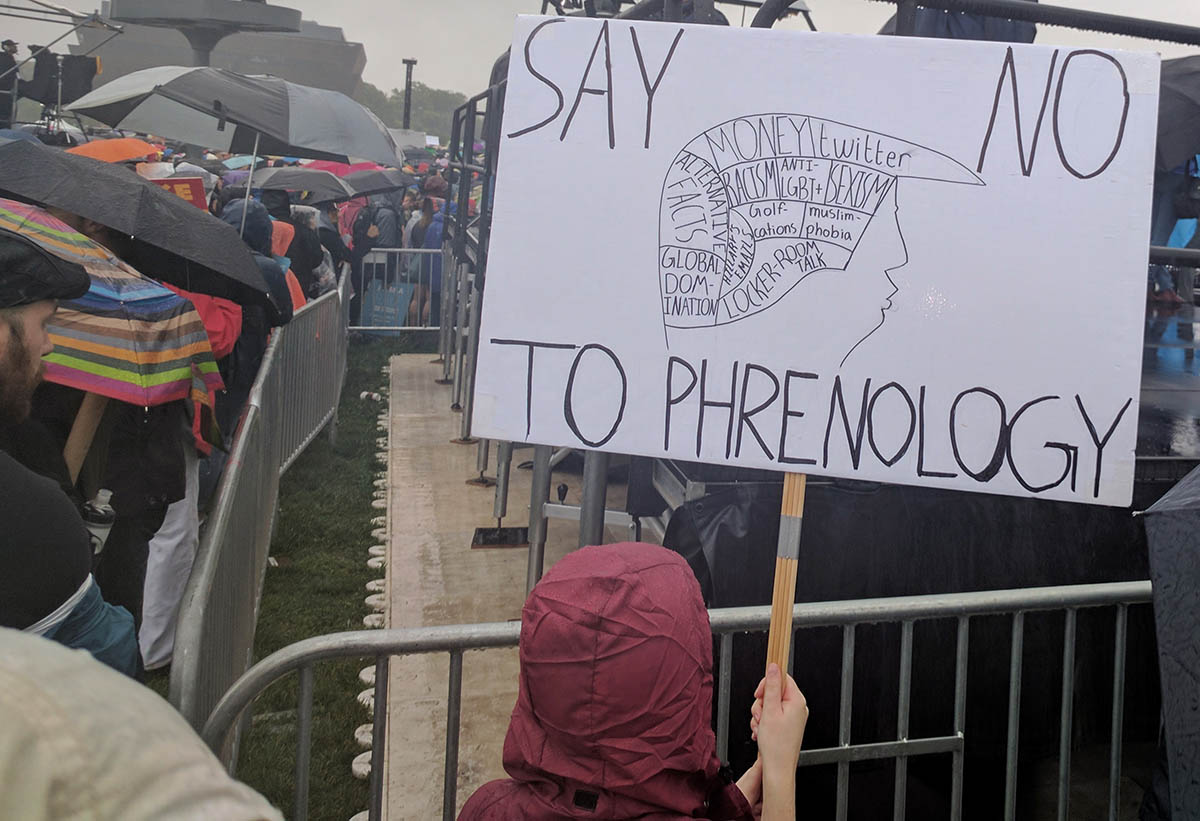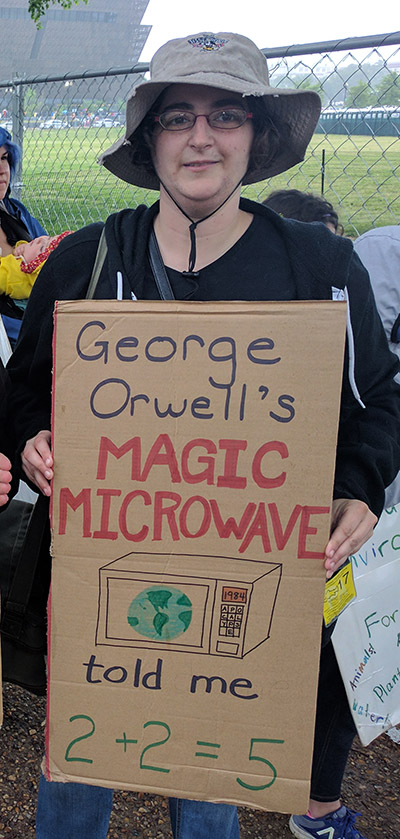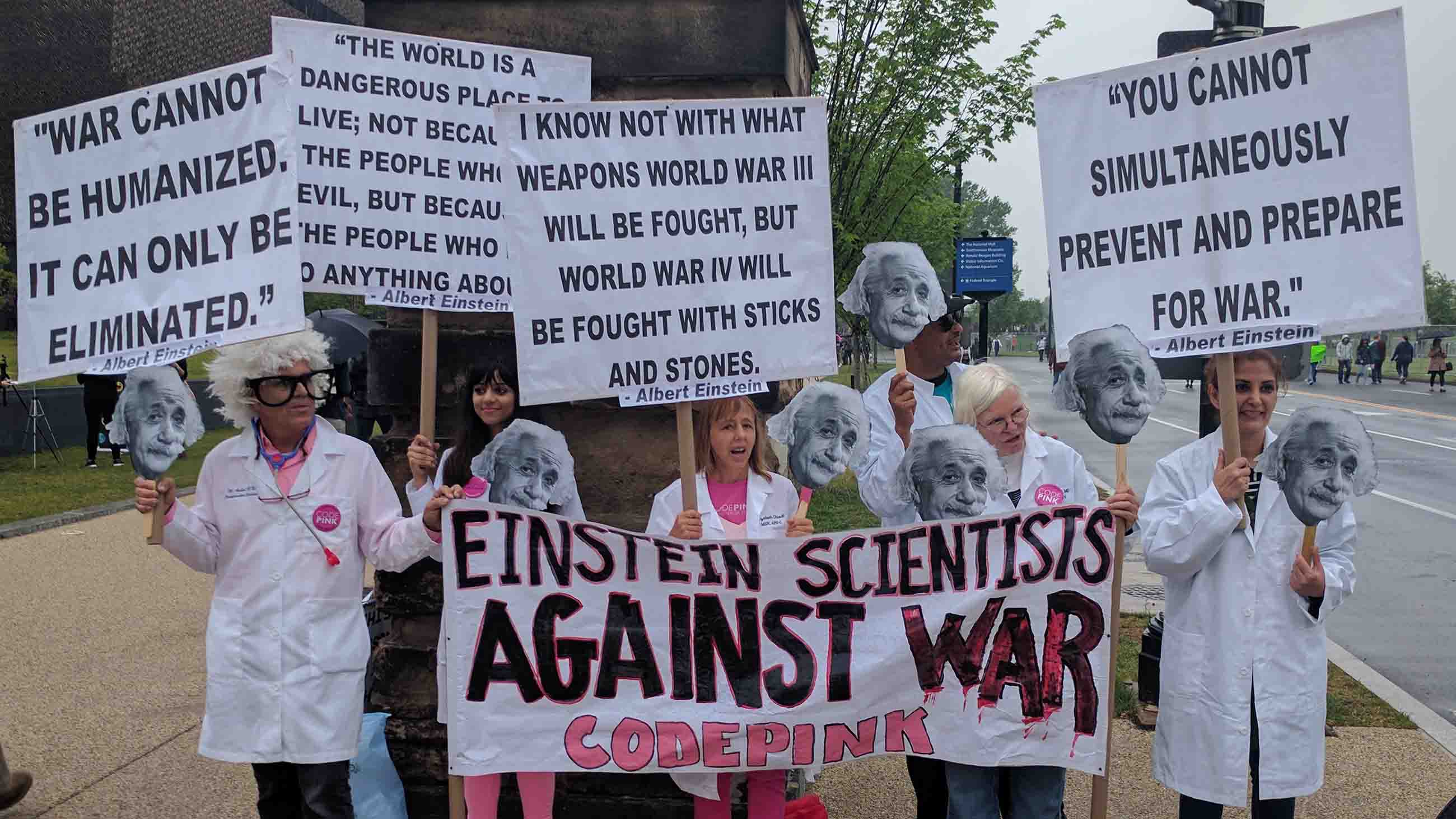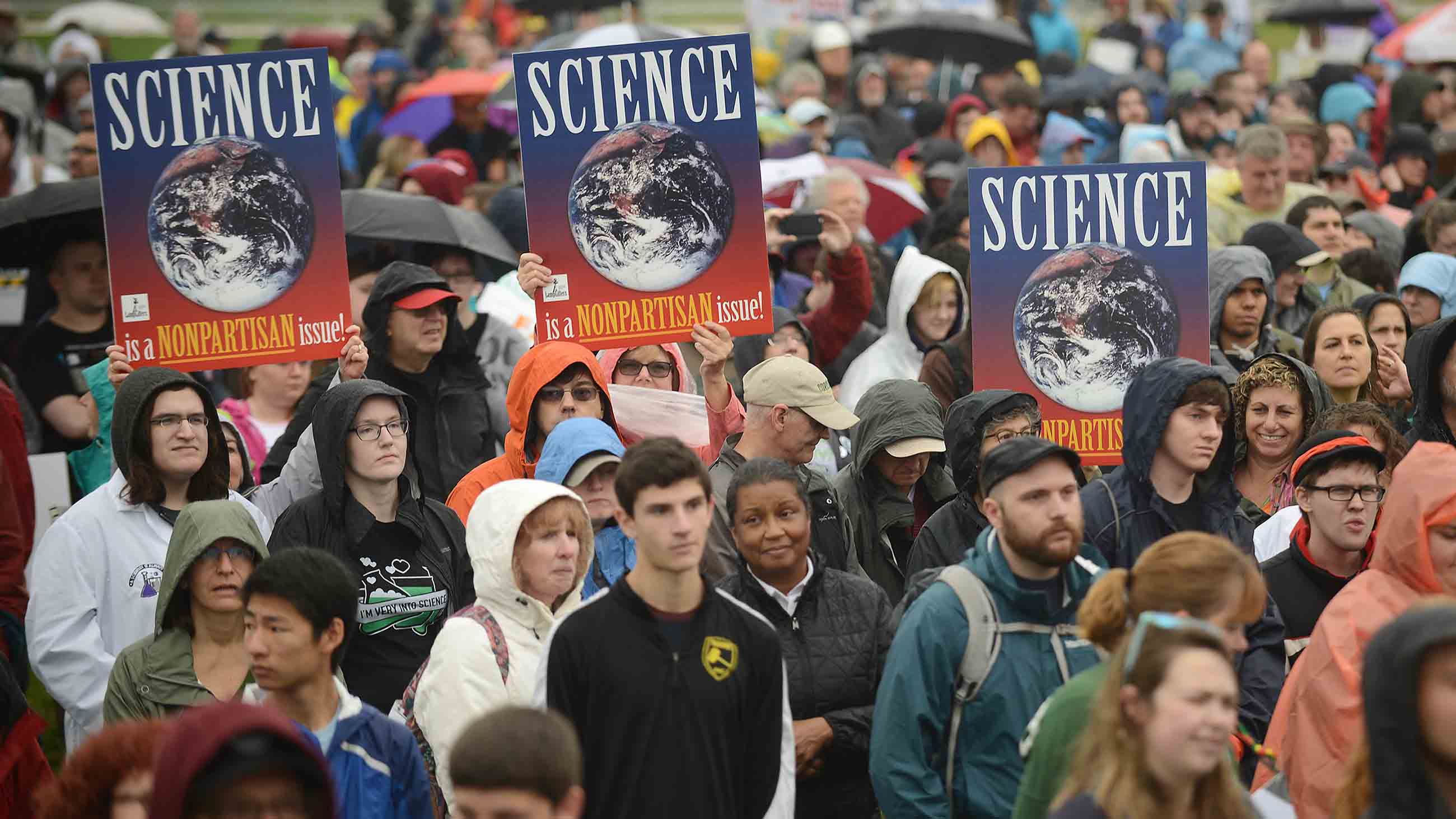The March for Science Was About Much More Than Trump
When she was in the Siberian Arctic, Margaret Williams said, a native friend asked her a riddle: Sometimes, when you’re out on the ice in a dogsled, a blizzard hits and things go white. You can’t see anything. The sled is useless. The dogs, blinded and terrified, refuse to move. What do you do then?
Williams, the World Wildlife Fund’s managing director for the Arctic, was speaking to a packed pavilion tent on “What Is the Arctic We Need to Sustain the Global Climate System?” one of a couple of dozen “teach-ins” at the Washington March for Science last Saturday. (There were others on “Saving Native Bees” and “The Role of Science in Ocean Conservation,” and even a couple with an industry bent, like “Plants With Superpowers,” about the upsides of GMOs.)
These talks were educational with an activist agenda — meant to help marchers learn about local environmental issues and how to develop civic engagement techniques to take action. There was not a great deal of time, so the scientists in the Arctic tent spoke quickly. They discussed how melting ice caps, which seem so far away, were a crucial part of the planetary climate systems our civilization is built on and how “the fate of Greenland would also be the fate of Miami.” So what do you do then? The scientists had a policy platform: recognize the crucial role of the Arctic, educate people, and get them to lobby for it.
But mostly what they offered was an ethos. Think, Williams said, of those sled dogs. When the whiteout hits and they refuse to move, you step off the runners of the sled, “strap on your skis, and lead.”
The Arctic scientists — like dozens of other scientists at the teach-ins and thousands at the more than 600 Marches for Science around the globe — were proposing a leap into a newly activist role. As the marches took shape in barely two months — from an inchoate tangle of Twitter and Reddit threads into a bona fide international movement — there had been a great deal of argument and speculation about what sort of events they would be. Critics argued that they would discredit science by identifying it with leftist causes. Others, like Ed Yong in The Atlantic, were favorable to the movement but noted that many of the nascent organization’s stated goals were contradictory, that it seemed confused as to what it really stood for.
That last question has now been answered — if not definitively, at least in a way that points a clear direction forward. Saturday’s marches served as a coming-out party for an unapologetically activist and political — though nonpartisan — movement, based around spontaneous participation and the idea that those who see the problems have the responsibility to hop off the stalled sled and pull it themselves. As I huddled in the rain outside the tent with the dozen other poor souls who hadn’t been able to get seats, I could just hear the march’s emcee, Derek Muller of the science video site Veritasium, on the main stage, across the Mall and just below the Washington Monument. “People say science isn’t political,” he said. “But science is totally political. When science says your water is polluted, that’s a political problem.” A few minutes later, Denis Hayes, organizer of the first Earth Day, opened his speech by saying, “Let me ask you: Did Americans vote to melt the ice caps? To warm the climate? To cut off research in Chesapeake Bay? Because that’s what we got.”
This point was made, over and over, both in the programming and in the words and actions of marchers: Science lets you know that there’s a problem, and then it is up to you to act. Up on stage were two honorary co-chairs for the movement who came from this tradition — Dr. Mona Hanna-Attisha, the pediatrician who played an outsized role in blowing open the water crisis in Flint, Michigan, and Lydia Villa-Komaroff, who has held high research positions at Northwestern University and in biotech, but who also co-founded Sacnas, the Society for the Advancement of Chicanos and Native Americans in Science.

As I walked around the Mall on Saturday, looking at the people who had pulled slipcovers over their cardboard signs and set out into the rain, it struck me that the endless pre-march opinion pieces asking whether marching was political, or a good idea, or quite what it “meant” to march for science, had missed something important. By focusing on the stated goals, as Yong did, and on what the march would or would not accomplish, they had missed its true character.
There was something faintly ridiculous about journalists’ grilling the organizers about what the march “stood for,” because the organizers — however much time they had spent crafting mission statements — were not really leading the movement. Rather, they were the foam atop a wave rising from below, a product of the spontaneous connections that form when a diverse collection of motivated people are in a room together — with potentially subversive and far-reaching consequences for the way science is funded and practiced.
Critics had worried that the march would be interpreted as nakedly partisan and anti-Trump. But in my interviews with marchers, Trump came up less as a political figure than as a shorthand for all that had gone wrong in the world of empiricism and the shared collective reality — the way that previously worrisome trends had hardened into a crisis that demanded a different sort of action.

“My students believe what the politicians say,” said Nicki Koller, a science teacher in Harrisburg, Pennsylvania.
Visual: Saul Elbein for Undark
They had been uneasy about the way things had been going, and Trump’s election spurred them into action. Nicki Koller, a science teacher from inner-city Harrisburg, Pennsylvania, had come down with her husband because she was worried about the effects of a “post-fact” world on her students. “My students believe what the politicians say,” she said. “They’ll hear people say that global warming isn’t caused by human activity — and they’ll push back in class. They don’t understand how to evaluate sources of information.”
Kathy Nagle, who studies and teaches phonetics and speech pathology at Seton Hall University in New Jersey, said Trump’s election had suggested to her that perhaps a political life built on simply voting wasn’t good enough. She had come down with Kathryn Greenslade, a speech scientist who recently graduated from the University of Washington. Before November 2016, neither had ever thought they would march, for science or anything else. But after the news of potential 18 percent cuts to the National Institutes of Health under Trump’s new budget proposal, they had felt they had to do something, because it seemed their entire discipline might be under threat.
Like those Arctic scientists at the teach-in, Nagle and Greenslade fit a larger pattern: the way that people look around their own (often tightly circumscribed) worlds and see things that worry them for the system as a whole. Not only does defunding threaten new research — it upsets the process by which empirical skills and good careers get passed on to the next generation. Under the current iron logic of research universities, you need grants to do research, research to get tenure, and tenure to have the intellectual and financial freedom to do good science. Without the necessary funding, as Greenslade put it, “potentially a whole future generation of scientists don’t get the training they need.” They never get to practice formal lab skills or learn to use evidence outside of rote training in making decisions.
“You can just tell them what evidence is, and what to do in the lab, and not train them to think,” Greenslade said. “And that’ll be fine for now. But it means in 20 years they’ll still be teaching the evidence of 20 years ago.” And by then — as the older generation who should have taught them dies or retires — they’ll be unable to pass on the empirical skills that they themselves never learned.
Of course, these worrisome trends go far beyond Trump or cuts to the NIH. They are part of a larger crisis in the way America does science. The very term “science” is often a shorthand for the specific funding-research-policy axes that grew up after World War II, as research universities flush with federal dollars churned out data that was then used to drive policy. Long before Trump, this system was beset by forces both internal and external: metastasizing bureaucracy in university administration; increasing pressure on researchers to find funding and produce concrete results; and, perhaps worst of all, the near-ubiquitous delegation of education to adjuncts, which cheats the students of experienced teachers and the adjuncts themselves of the chance to rise through the ranks of science.

Awareness of the threat to science, writ large, is hardly limited to young grassroots activists. Even before the election, “I was particularly concerned about evidence and respect for evidence, and how opinion and assertion was crowding it out of public policy,” said Rush Holt, head of the American Association for the Advancement of Science. But most scientists, he said, have “been busy with their research, and they haven’t paid attention to the erosion in the appreciation of science, or about whether the conditions in which science thrives will continue.”
Holt had watched a sea change in those attitudes since the election, as thousands of scientists seemed to come to, look around, realize the straits they were in, and begin to act. For many, activism started immediately in small ways: I heard stories of scientist phone banks in people’s houses and meet-your-neighbors potlucks. This spread to many who know they depend on science, people like Len Copicotto, a mid-30s union electrician who had come down from New York with his wife, who teaches biology at Nassau Community College. (He carried a sign with a quote from Carl Sagan: “Extinction is the rule: survival is the exception.” The guys he works with, Copicotto said, need an understanding of science and math — things like voltage drops and other features of electrical systems — “to make it home safe”; but they rarely seem to make that connection, or to reflect on the need to hold positions based on evidence. “Since the Fairness Doctrine went away,” he said, “lots of guys don’t realize that what they’re getting is hyper-partisan.” He laughed. “My dad grew up trusting Tom Brokaw. Thinks everything on cable is to be trusted.” Copicotto has started a project around “blue-collar media literacy,” with the aim of spreading critical media consumption tools among organized labor.
Some scientists who had already been working on activist projects brought those ideas with them to the march. Juan Pablo Ruiz, a doctoral student in biomedical sciences from Bethesda, Maryland, who runs the Labmosphere blog, has been focused on the internal problems like “lab bullying” that can make labs toxic places to work, causing them to hemorrhage young scientists. The idealized system in which investigators mentor young scientists, he said, is already gone in many institutions. Now one investigator may run hundreds of research assistants, and such abuse is often rampant and unchecked. “Lots of people wash out,” he said. “They say, ‘I can’t do science anymore.’ But really it’s not science — it’s the culture of academia.”
Some more explicitly activist organizations came to the march to recruit. Ashley Hunt-Martorano, a West Virginia native who remembers watching as the mountains around her town were blasted away for coal, was there with the Citizens’ Climate Lobby, which trains activists to lobby their members of Congress — particularly Republicans — for carbon legislation. They deploy an ideologically agnostic line of argument that avoids the word “environment.” “Our favorite phrase — Republicans love this — is that a carbon tax bill is ‘an economic and jobs bill with climate benefits,’” she said, as CCL volunteers fanned out to invite science marchers to their lobbying training the next day. They’ve noticed a big post-Trump surge in support — 30 percent of their membership joined since November 8 — and are gearing up for the People’s Climate March on April 29.
Perhaps the most important result of the March for Science was to give these people, and hundreds of thousands more around the world, a venue, a goal, and an opportunity to meet their counterparts at other institutions and in other disciplines. “There aren’t really venues for people like us to do this,” Kathryn Greenslade, the speech researcher, said, looking around a downtown Starbucks swollen with marchers fleeing the rain but not yet ready to go home. The cafe had become an impromptu salon, where mathematicians and linguists sat around talking and watching the march speeches on tablets. It was the first time in a long while that she’d been around so many scientists.
The March for Science stands to reverse this trend toward siloing. Earth Day is over, but the march’s infrastructure — a loose but energized coalition of hundreds of partner groups — remains in place. New relationships have been formed and new networks built through the process of building the march, through casual meetings at the after-parties in Dupont Circle. There is no telling where those sorts of connections will end.
Caroline Weinberg, the New York public health physician and activist who became one of the march’s chief organizers, says the next step is to build an institution that fosters that sort of spontaneous meeting and conversation among scientists of different fields — and the concrete action that comes about as a result. The organizers want to begin converting the structure they built into the scaffolding for a sort of interdisciplinary congress of science organizations. When I spoke to her by phone after the march, as she walked to a forum for partner organizations to discuss the next phase, she was cagy about what came next, partly because “given how much it got out of hand at the beginning, we’re trying to keep it under wraps until we’re ready.”
But partly she seems cagy because that process is evolving, and there is no way to know quite where it’s going. As in Stanley Miller’s famous “primordial soup” experiment, put reactive elements in a glass and zap it with lightning, and they’ll form basic structures, then more complex ones, all on their own. “It seemed like just a line, ‘The real work starts after the march,’” Weinberg said, laughing, “but it’s really true. There’s no end date now, which is scary.” Still, she sounded almost giddy with both relief and excitement, as she looked forward a movement breaking free of the glass and staggering to life.










